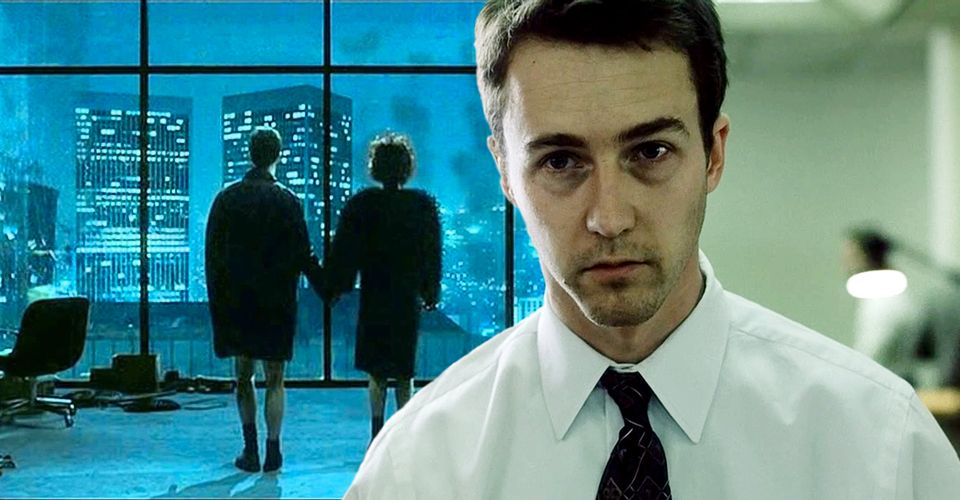Fight Club Ending Explained (In Detail)

It may boast one of the most iconic endings of all time, but Fight Club‘s final scenes still elicit confusion due to the film’s infamous mind-bending twist. Based on the 1996 novel of the same name by Chuck Palahniuk, David Fincher’s Fight Club has continued to entertain in the decades since its release. The film combines a complex and thrilling human story with a level of social commentary and an exploration of the toxic nature of modern society that has seen Fight Club subjected to serious analysis.
Told from the perspective of its unnamed narrator (played by 2008 Hulk, Edward Norton), Fight Club details his life spiraling into anarchy after founding the titular club. The Narrator begins Fight Club‘s story as a disillusioned office worker struggling with insomnia, but through meeting the mysterious and charismatic Tyler Durden (Brad Pitt), he begins to live a more fulfilling life. However, Durden’s exploits soon escalate, leaving the Narrator to try to resolve the resulting chaos.
In one of the most well-known movie twists of all time, Tyler Durden is revealed to have been the Narrator himself – Norton’s character had imagined Durden as a separate being in order to make sense of his own inner conflict. This clever piece of storytelling reframes Fight Club‘s entire narrative, but it also makes its ending somewhat ambiguous. However, thanks to the numerous themes and ideas at work throughout Fight Club, its meaning can be unpacked with relative ease.
What Happens In Fight Club’s Ending

In the years since Fight Club‘s ending twist, it has been recreated and reused for a number of stories, and that’s because it’s both thought-provoking and emblematic of much deeper themes. However, Fight Club‘s ending is a relatively abrupt one – after learning that Tyler only exists in his mind, the Narrator shoots himself and then stands with his girlfriend, Marla, and watches the decimation of the city skyline. There are a number of implications to this scene, but one of the biggest is that after Fight Club‘s twist, the main character cannot be considered a reliable narrator.
As most of Fight Club didn’t happen at all as the Narrator had told it, the ending becomes even more ambiguous. However, taken at face value, it shows that the Narrator is finally free of Brad Pitt’s Tyler Durden, but that he can’t stop Project Mayhem’s plan, and so he simply watches it unfold. The implications of this are that Project Mayhem’s other groups across the globe will likely succeed in their mission, too, dealing a serious blow to the consumerist society that Tyler was rebelling against.
The ending is easy to misread, as everything that came before it is already called into question. However, the destruction of the buildings that the Narrator watches with Marla appears to really be unfolding, and Fight Club‘s protagonist appears to have fully regained control of himself. This means that Fight Club‘s ending should be considered free of the cynical eye that its twist casts over most of the film’s events.
Is Tyler Durden Really Dead?

In order to play the imaginary Tyler Durden, Brad Pitt’s Fight Club workout routine was brutal, culminating in Durden’s tough, wiry look. However, in the film’s final scene, the Narrator shoots himself in the face – something that all Tyler’s (imaginary) muscles can’t help him with – seemingly killing the psychological manifestation of his own inner conflict. But, with the Narrator’s questionable sanity central to Fight Club‘s story, can the imaginary Tyler Durden really be killed?
Of course, a bullet can’t physically harm Durden – as he has no physical body to harm – but it’s not the bullet that kills him, it’s the action itself. Throughout Fight Club, Tyler tells the Narrator to surrender control, and in shooting himself, he both surrenders it and seizes it in one single action. This is ultimately what dismisses Durden: the choice to act in a way that removes all control both defies and appeases Tyler, allowing the Narrator to regain a grasp on his own sanity. David Fincher’s comments on mental illness in Fight Club seem to be a statement on empowerment – by confronting his own struggles (albeit in an incredibly self-destructive way), the Narrator begins to move past them.
Is Marla Real? Helena Bonham Carter’s Character Explained

After Tyler Durden is proved to only exist in the Narrator’s head, there’s also some confusion as to whether or not Marla is real or imaginary. Throughout Fight Club, Marla is something of a grounding influence for the Narrator, acting as a sense of comfort in the antithesis of his relationship with Tyler (himself). This creates a sense that where Tyler Durden is the embodiment of the Narrator’s rage and frustration, Helena Bonham Carter’s Marla is a representation of his tendency for self-destructive behavior.
This isn’t something that can be entirely proven, or disproven, by the events of the film. As Fight Club establishes the Narrator’s ability to create imaginary constructs that he believes to be real, Marla could also be imaginary, although his choice to embrace her after “killing” Tyler then takes on a new meaning. Regardless, Marla’s relationship with the Narrator is both loving and abusive, which is a reflection of his relationship with Tyler (and therefore, himself).
Fight Club’s Anti-Consumerism & Masculinity Themes Explained

One of Fight Club‘s most obvious themes is that of anti-consumerism and its incompatibility with modern society. This is at the forefront of the film’s story, with a number of Tyler’s monologues delivered on exactly that subject. However, this is used as a front for the Narrator’s deeper-seated issues, with Tyler using them as a smokescreen to distract him from his own mental state. Fight Club‘s Starbucks cups and subliminal imagery used before Tyler’s introduction hint that consumerism is responsible for the Narrator creating the Tyler Durden persona, although the dynamic between the two characters is indicative of something more profound.
The Narrator’s creation of Tyler is representative of his struggle with his own masculinity. Tyler embodies all the qualities the Narrator wishes he had and is seemingly free of any inhibitions – something that the Narrator continues to struggle with after Tyler’s introduction. This is evidenced in the senseless violence and eventual terrorism that Tyler inspires in others, and its something that the Narrator protests. Tyler embodies toxic masculinity masquerading as a replacement for true therapy, as evidenced by his treatment of Marla and the way he physically manifests to the Narrator.
The Real Meaning Of Fight Club’s Ending

The ideas behind its ending almost make Fight Club the perfect Joker origin story, but it actually ends on a much more hopeful tone for its unnamed Narrator. By shooting himself, he seemingly dismisses his Tyler Durden persona, winning the fight for control that he hadn’t realized he’d been fighting all along. This allows him to join Marla as they watch the fallout of his behavior, which is far more significant than it may seem.
Fight Club‘s ending implies consequences for the Narrator’s actions. He was able to banish Tyler from his head, but only by severely hurting himself. He took control of himself too late, and the damage was already done, but instead of shying away from it, he resigns himself to watch as it unfolds. It’s only when he chooses to confront his issues that he seems to find a sense of peace, even if he can’t truly resolve the actions he didn’t know he was responsible for throughout Fight Club.
About The Author

















